2019 Hyundai Tucson tire pressure
[x] Cancel search: tire pressurePage 482 of 546
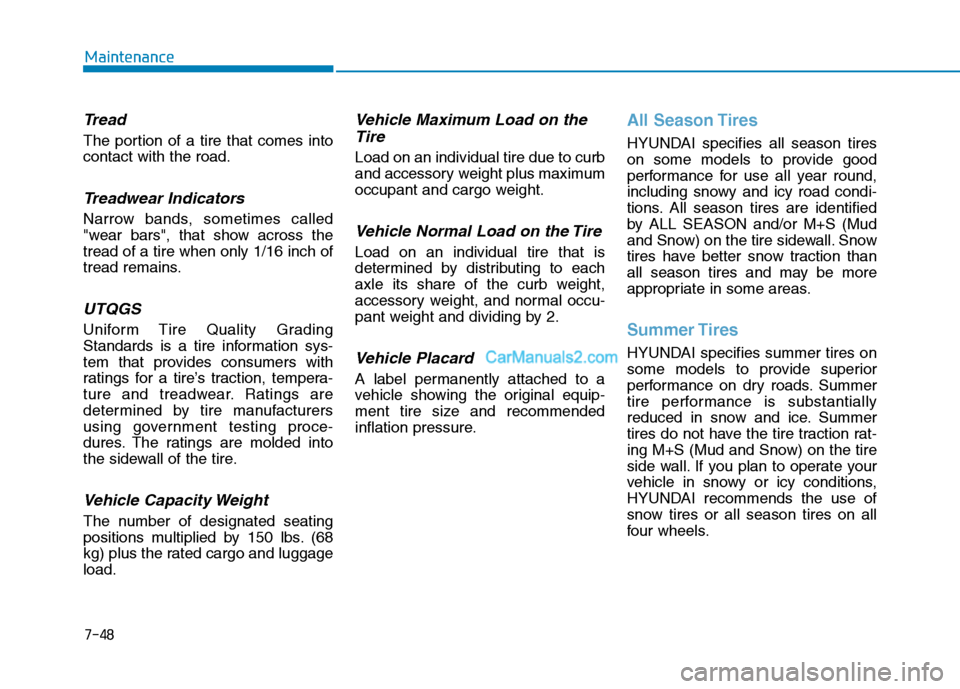
7-48
Maintenance
Tread
The portion of a tire that comes into
contact with the road.
Treadwear Indicators
Narrow bands, sometimes called
"wear bars", that show across the
tread of a tire when only 1/16 inch of
tread remains.
UTQGS
Uniform Tire Quality Grading
Standards is a tire information sys-
tem that provides consumers with
ratings for a tire’s traction, tempera-
ture and treadwear. Ratings are
determined by tire manufacturers
using government testing proce-
dures. The ratings are molded into
the sidewall of the tire.
Vehicle Capacity Weight
The number of designated seating
positions multiplied by 150 lbs. (68
kg) plus the rated cargo and luggage
load.
Vehicle Maximum Load on the
Tire
Load on an individual tire due to curb
and accessory weight plus maximum
occupant and cargo weight.
Vehicle Normal Load on the Tire
Load on an individual tire that is
determined by distributing to each
axle its share of the curb weight,
accessory weight, and normal occu-
pant weight and dividing by 2.
Vehicle Placard
A label permanently attached to a
vehicle showing the original equip-
ment tire size and recommended
inflation pressure.
All Season Tires
HYUNDAI specifies all season tires
on some models to provide good
performance for use all year round,
including snowy and icy road condi-
tions. All season tires are identified
by ALL SEASON and/or M+S (Mud
and Snow) on the tire sidewall. Snow
tires have better snow traction than
all season tires and may be more
appropriate in some areas.
Summer Tires
HYUNDAI specifies summer tires on
some models to provide superior
performance on dry roads. Summer
tire performance is substantially
reduced in snow and ice. Summer
tires do not have the tire traction rat-
ing M+S (Mud and Snow) on the tire
side wall. If you plan to operate your
vehicle in snowy or icy conditions,
HYUNDAI recommends the use of
snow tires or all season tires on all
four wheels.
Page 483 of 546
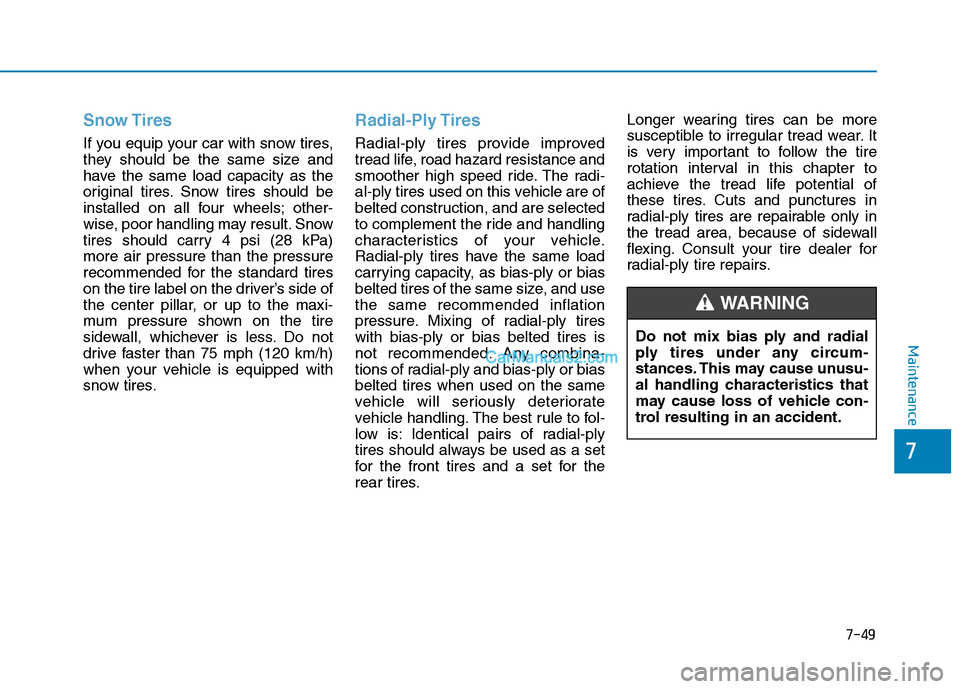
7-49
7
Maintenance
Snow Tires
If you equip your car with snow tires,
they should be the same size and
have the same load capacity as the
original tires. Snow tires should be
installed on all four wheels; other-
wise, poor handling may result. Snow
tires should carry 4 psi (28 kPa)
more air pressure than the pressure
recommended for the standard tires
on the tire label on the driver’s side of
the center pillar, or up to the maxi-
mum pressure shown on the tire
sidewall, whichever is less. Do not
drive faster than 75 mph (120 km/h)
when your vehicle is equipped with
snow tires.
Radial-Ply Tires
Radial-ply tires provide improved
tread life, road hazard resistance and
smoother high speed ride. The radi-
al-ply tires used on this vehicle are of
belted construction, and are selected
to complement the ride and handling
characteristics of your vehicle.
Radial-ply tires have the same load
carrying capacity, as bias-ply or bias
belted tires of the same size, and use
the same recommended inflation
pressure. Mixing of radial-ply tires
with bias-ply or bias belted tires is
not recommended. Any combina-
tions of radial-ply and bias-ply or bias
belted tires when used on the same
vehicle will seriously deteriorate
vehicle handling. The best rule to fol-
low is: Identical pairs of radial-ply
tires should always be used as a set
for the front tires and a set for the
rear tires.Longer wearing tires can be more
susceptible to irregular tread wear. It
is very important to follow the tire
rotation interval in this chapter to
achieve the tread life potential of
these tires. Cuts and punctures in
radial-ply tires are repairable only in
the tread area, because of sidewall
flexing. Consult your tire dealer for
radial-ply tire repairs.
Do not mix bias ply and radial
ply tires under any circum-
stances. This may cause unusu-
al handling characteristics that
may cause loss of vehicle con-
trol resulting in an accident.
WARNING
Page 484 of 546
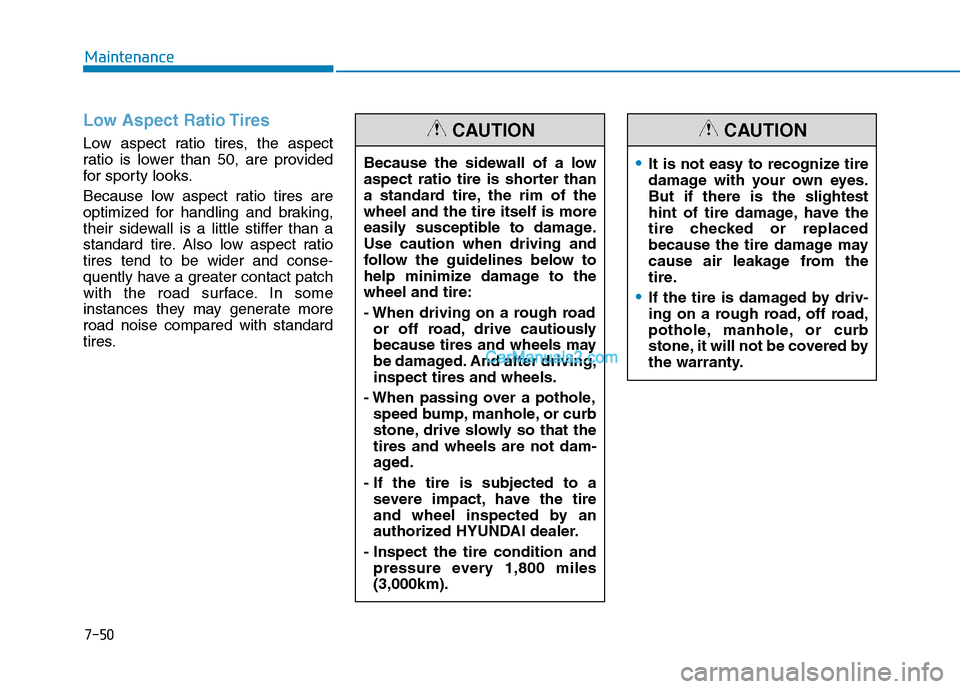
7-50
Maintenance
Low Aspect Ratio Tires
Low aspect ratio tires, the aspect
ratio is lower than 50, are provided
for sporty looks.
Because low aspect ratio tires are
optimized for handling and braking,
their sidewall is a little stiffer than a
standard tire. Also low aspect ratio
tires tend to be wider and conse-
quently have a greater contact patch
with the road surface. In some
instances they may generate more
road noise compared with standard
tires.Because the sidewall of a low
aspect ratio tire is shorter than
a standard tire, the rim of the
wheel and the tire itself is more
easily susceptible to damage.
Use caution when driving and
follow the guidelines below to
help minimize damage to the
wheel and tire:
- When driving on a rough road
or off road, drive cautiously
because tires and wheels may
be damaged. And after driving,
inspect tires and wheels.
- When passing over a pothole,
speed bump, manhole, or curb
stone, drive slowly so that the
tires and wheels are not dam-
aged.
- If the tire is subjected to a
severe impact, have the tire
and wheel inspected by an
authorized HYUNDAI dealer.
- Inspect the tire condition and
pressure every 1,800 miles
(3,000km).CAUTION
It is not easy to recognize tire
damage with your own eyes.
But if there is the slightest
hint of tire damage, have the
tire checked or replaced
because the tire damage may
cause air leakage from the
tire.
If the tire is damaged by driv-
ing on a rough road, off road,
pothole, manhole, or curb
stone, it will not be covered by
the warranty.
CAUTION
Page 522 of 546
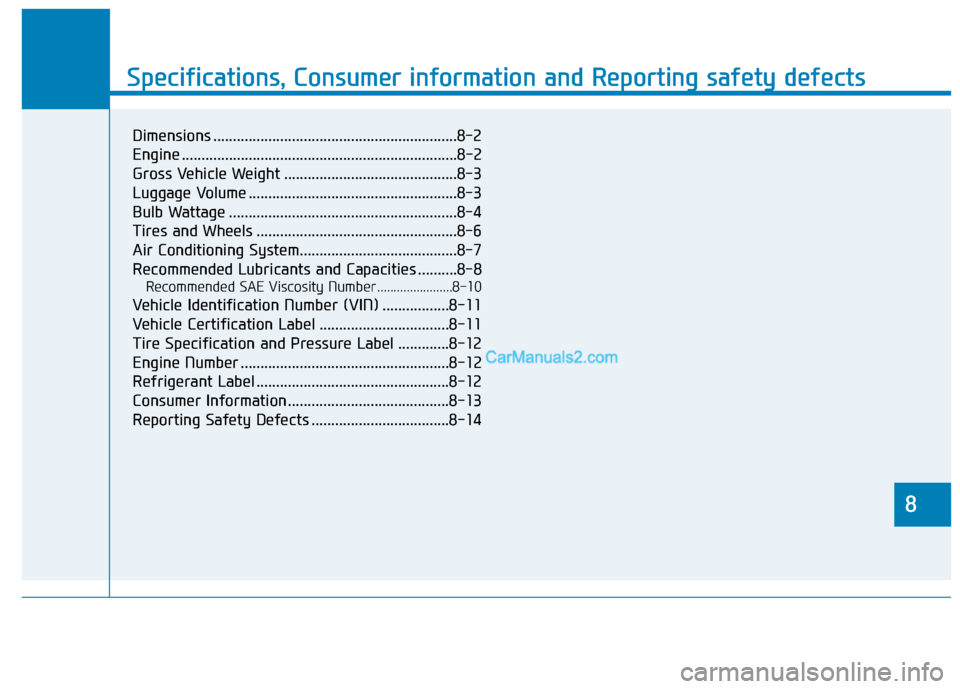
Specifications, Consumer information and Reporting safety defects
8
Dimensions ..............................................................8-2
Engine ......................................................................8-2
Gross Vehicle Weight ............................................8-3
Luggage Volume .....................................................8-3
Bulb Wattage ..........................................................8-4
Tires and Wheels ...................................................8-6
Air Conditioning System........................................8-7
Recommended Lubricants and Capacities ..........8-8
Recommended SAE Viscosity Number .......................8-10
Vehicle Identification Number (VIN) .................8-11
Vehicle Certification Label .................................8-11
Tire Specification and Pressure Label .............8-12
Engine Number .....................................................8-12
Refrigerant Label .................................................8-12
Consumer Information .........................................8-13
Reporting Safety Defects ...................................8-14
Page 527 of 546
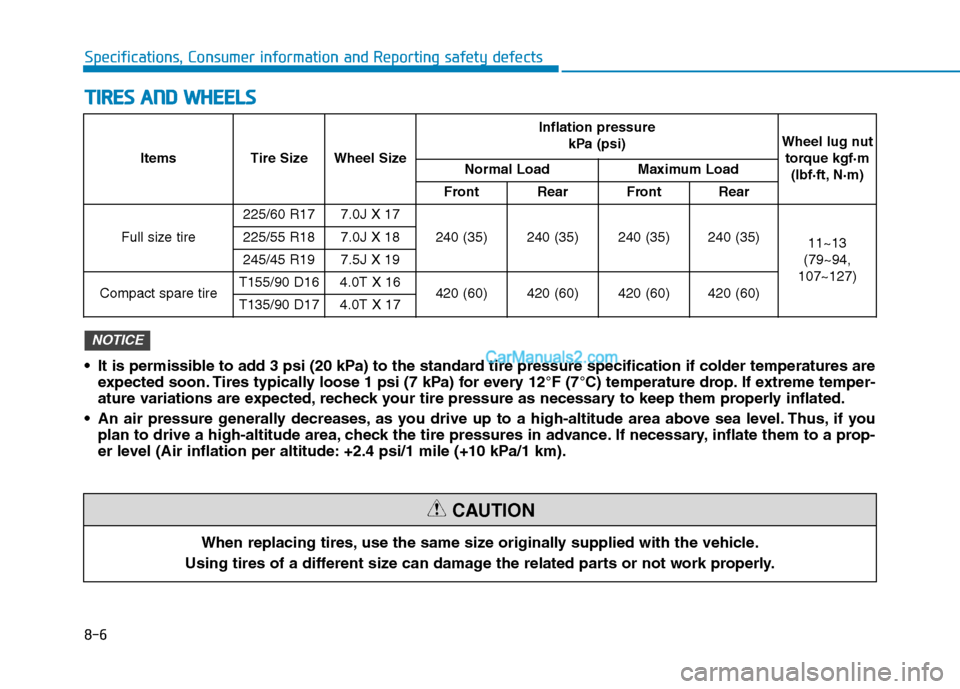
8-6
Specifications, Consumer information and Reporting safety defects
T TI
IR
RE
ES
S
A
AN
ND
D
W
WH
HE
EE
EL
LS
S
When replacing tires, use the same size originally supplied with the vehicle.
Using tires of a different size can damage the related parts or not work properly.
CAUTION
Items Tire SizeWheel Size
Inflation pressure
kPa (psi)Wheel lug nut
torque kgf·m
(lbf·ft, N·m)
Normal LoadMaximum Load
FrontRearFrontRear
Full size tire
225/60 R177.0J X 17
240 (35)240 (35)240 (35)240 (35)11~13
(79~94,
107~127)225/55 R187.0J X 18
245/45 R197.5J X 19
Compact spare tireT155/90 D164.0T X 16420 (60)420 (60)420 (60)420 (60)T135/90 D174.0T X 17
It is permissible to add 3 psi (20 kPa) to the standard tire pressure specification if colder temperatures are
expected soon. Tires typically loose 1 psi (7 kPa) for every 12°F (7°C) temperature drop. If extreme temper-
ature variations are expected, recheck your tire pressure as necessary to keep them properly inflated.
An air pressure generally decreases, as you drive up to a high-altitude area above sea level. Thus, if you
plan to drive a high-altitude area, check the tire pressures in advance. If necessary, inflate them to a prop-
er level (Air inflation per altitude: +2.4 psi/1 mile (+10 kPa/1 km).
NOTICE
Page 545 of 546

I-10
Theft-Alarm System .......................................................3-20
Tilt Steering/Telescope Steering .....................................3-22
Tire Pressure Monitoring System (TPMS) .......................6-8
Changing a Tire with TPMS ......................................6-12
Check Tire Pressure......................................................6-8
Low Tire Pressure LCD Display with
Position Indicator ....................................................6-10
Low Tire Pressure Telltale..........................................6-10
Tire Pressure Monitoring System.................................6-9
TPMS Malfunction Indicator .....................................6-11
Tire Specification and Pressure Label ............................8-12
Tires and Wheels .....................................................7-36, 8-6
All Season Tires .........................................................7-48
Check Tire Inflation Pressure .....................................7-38
Low Aspect Ratio Tires ..............................................7-50
Radial-Ply Tires ..........................................................7-49
Recommended Cold Tire Inflation Pressures.............7-37
Snow Tires ..................................................................7-49
Summer Tires .............................................................7-48
Tire Care .....................................................................7-36
Tire Maintenance ........................................................7-41
Tire Replacement........................................................7-40
Tire Rotation...............................................................7-38
Tire Sidewall Labeling ...............................................7-41
Tire Terminology and Definitions ..............................7-45Tire Traction ...............................................................7-41
Wheel Alignment and Tire Balance ...........................7-39
Wheel Replacement....................................................7-41
Towing ............................................................................6-21
Emergency Towing.....................................................6-23
Removable Towing Hook...........................................6-22
Tie-down Hook...........................................................6-25
Towing Service ...........................................................6-21
Trailer Towing...............................................................5-130
Driving with a trailer ................................................5-133
If you decide to pull a trailer....................................5-130
Maintenance when trailer towing .............................5-136
Trailer towing equipment .........................................5-132
Trip Computer ...............................................................3-103
USB Charger .................................................................3-162
Vehicle Certification Label .............................................8-11
Vehicle Identification Number (VIN) .............................8-11
Vehicle Load Limit .......................................................5-138
Tire Loading Information Label...............................5-139
Vehicle Stability Management (VSM)............................5-39
Index
U
V
T